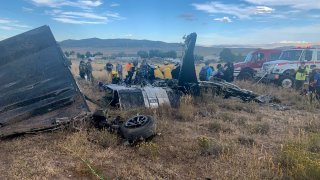
The mid-air collision that killed two racing pilots in Reno last weekend is confounding aviation experts.
The first- and second-place winning pilots, both Californians, crashed Sunday at the National Air Race Championships, possibly because of an aircraft blind spot, glare from the sun or even a brief moment of lost focus, experts said.
But many are dumbfounded by the fact that such experienced pilots who’d raced their T-6 warbirds at the same site so many times couldn't navigate trouble just seconds away from safely returning to the tarmac at Reno-Stead Airport.
“Honestly, it is very hard for me to find an explanation for how those two expert pilots ended up in the same piece of airspace at the same time,” Reno Air Racing Association CEO Fred Telling said.
Get a weekly recap of the latest San Francisco Bay Area housing news. Sign up for NBC Bay Area’s Housing Deconstructed newsletter.
Telling, who raced T-6s for 10 years, doubts there was a mechanical failure because someone would have radioed “Mayday.”
Both pilots made brief radio transmissions just before colliding, so a health episode seems unlikely.
It was an abrupt end to what was to be the celebrated finale of Reno’s run as the home of the national championships since 1964.
U.S. & World
“Obviously, a tragedy for all concerned and the fact it occurred after the last race of the last day of the last Reno air show is just beyond belief,” said Scott Miller, an aviation professor at San Jose State University and civilian flight instructor for 30 years.
“Like many pilots and spectators, when I first heard about it, I assumed the accident occurred during the race itself, not during landing sequence," he said. “Really surprised and shocked.”
Telling described the victims, Chris Rushing of Thousand Oaks and Nick Macy of Tulelake, as skilled, expert pilots. Rushing was the defending champion in the race he won Sunday. Macy, the runner-up, had won six times.
The National Transportation Safety Board, with assistance from the Federal Aviation Administration, is leading an investigation into the crash and will release a preliminary report in another week or two.
Investigators recovered wreckage this week from two debris fields about a half-mile (.8 kilometer) apart and transported it off-site, NTSB spokesperson Sarah Sulick said.
Event organizers were already looking for a new home for the competition after this year, partly because of rising insurance costs since 2011. That year a P-51D Mustang suffered a mechanical failure and crashed into the apron in front of the grandstand, killing the pilot and 10 spectators on the ground and seriously injuring another 70.
It was one of the deadliest air show disasters in U.S. history.
Richard McSpadden, former commander of the U.S. Air Force Thunderbirds, said the crash last week appears to have occurred in a transitional “cool-down” zone.
After racing at high speeds, a few feet from each other and 50 feet (15 meters) off the ground, it's a place where pilots circle more than 2,000 feet (609 meters) above. That's to allow their planes to slow and cool while their own adrenaline lowers before descending to about 1,000 feet (300 meters) on a looping, landing approach.
“It seems like the accident happened somewhere between the transition between the cool-down area and then the overhead pattern into the landing,” said McSpadden, senior vice president of the Aircraft Owners and Pilots Association’s Air Safety Institute.
McSpadden shared his initial take in a YouTube video posted by his organization. He said the large wings on the planes used to train World War II pilots can restrict visibility for the pilot who is higher, who might be “blind to the aircraft underneath them.”
“As event organizers, anytime we’re funneling airplanes into the same location ... that’s always a potential conflict," he said.
McSpadden said the Reno Air Racing Association is known for its thorough planning and emphasis on safety. New pilots must attend a training school where they're tested on procedures.
“These two pilots would have known them extremely well,” he said. “So the challenge for Reno is going to be to figure out, through all of these procedures and the lessons that they had: How did a gap occur to where they could have this kind of conflict?"
Telling believes the planes already had left their cool-down zone and were at an elevation preparing for landing, but agreed that visibility could have been an issue.
“If you are in a turn, something immediately below you would be blanked out,” he said. “Or it could have been the glare of the sun."
Miller suspects the pilots thought they were farther apart than they really were. He's never flown at Reno but has been told that planes typically fly at similar speeds during their landing pattern, “to make sure they keep that same relative separation.”
“I don't think that happened in this case," he said.
McSpadden said veteran pilots know it's important not to let their guard down but it can happen when they are so close to landing.
“We all know this, we’ve heard it many times," he said, “but the flight’s not over until the aircraft is shut down.”



